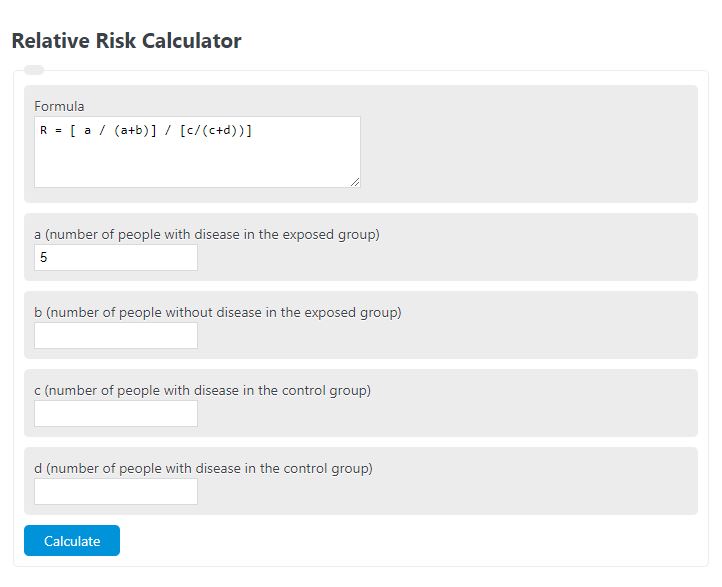Enter the total amount of people with a disease and without of two separate groups; one being the exposed group and one being the control. The calculator will determine the relative risk.
- Relative Error Calculator
- Conditional Probability Calculator
- Number Needed to Treat Calculator (NNT)
- Absolute Risk Reduction Calculator
Relative Risk Formula
The following equation can be used to calculate the relative risk of two groups of people.
R = [ a / (a+b)] / [c/(c+d))]
- Where R is the relative risk
- a is the number of people in the exposed group with a disease
- b is the number of people in the exposed group without the disease
- c is the number of people in the control or base group with the disease
- d is the number of people ins the control group without the disease
Relative Risk Definition
Relative risk is a statistical measure used to assess the likelihood of an event occurring in one group compared to another. It is a ratio that compares the probability of an outcome happening in one group to the probability of the same outcome occurring in another group.
One key application of relative risk is in studying the effects of exposure to certain risk factors on the development of diseases. For example, researchers may investigate the relative risk of developing lung cancer in smokers compared to non-smokers. By calculating the relative risk, they can quantify the increased likelihood of developing lung cancer among smokers, providing valuable information for public health interventions and targeted prevention strategies.
Relative risk also plays a vital role in clinical trials and in evaluating the effectiveness of interventions or treatments. Researchers compare the relative risk of an event occurring in the treatment group to that in the control group. This analysis enables them to determine whether the intervention has a significant impact on reducing the risk of the outcome or disease.
Relative Risk Example
How to calculate the relative risk?
- First, determine the number of people with the disease in the exposed group.
Measure variable a from the formula above.
- Next, determine the number of people without the disease in the exposed group.
Measure variable b from the formula above.
- Next, determine the number of people with the disease in the control group.
Measure variable c from the formula above.
- Next, determine the number of people without the disease in the control group.
Measure variable d from the formula above.
- Finally, calculate the relative risk.
Calculate the relative risk using the equation.
FAQ
How is relative risk different from absolute risk?
Relative risk compares the probability of an event occurring in two different groups, while absolute risk refers to the overall likelihood of the event happening in a single group without comparison.
Why is relative risk important in medical research?
Relative risk is crucial in medical research because it helps identify the strength of the association between an exposure (like smoking) and an outcome (such as lung cancer). This information is vital for developing prevention strategies and understanding disease mechanisms.
Can relative risk be used for predicting individual risk?
No, relative risk is a measure used to compare risk levels between groups and cannot directly predict an individual’s risk of developing a disease. Individual risk assessment requires more personalized information.
What does a relative risk value greater than 1 indicate?
A relative risk value greater than 1 indicates that the event is more likely to occur in the exposed group compared to the control group, suggesting a potential association between the exposure and the outcome.

